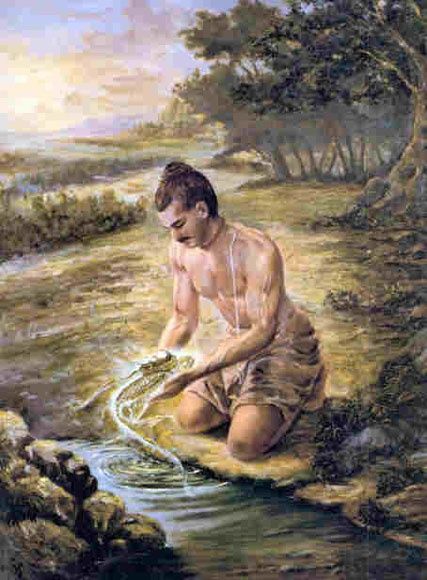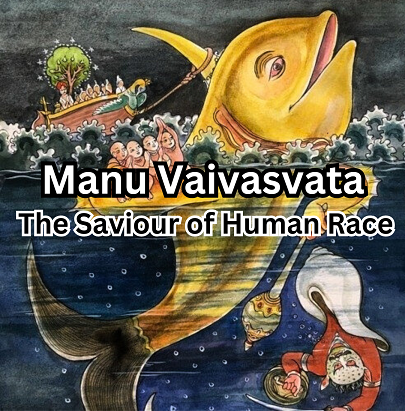Indian history is filled with the stories of legends. So much has been written in the sacred Hindu texts, bringing light to the forgotten and everlasting knowledge of Hindu culture, Philosophy, etc.
The Puranas which probably had compiled during the tenure of the great Guptas shed light on the various aspects of Hindu philosophy and history. These Puranic sources also tell us about the beginning of Indian history or human history.
The name Manu Vaivasvata holds a special and important place in the context of the origin of Indian history. According to the Hindu legends Manu Vaivasvata was the savior of the human race and later from him sprang the dynasties that ruled the Indian sub-continent.

However, Manu Vaivasvata was not the only Manu in Hindu legends. The Puranic sources mention the names of a total of fourteen Manu’s which are regarded as important figures in Indian history and consequently Indian historical tradition.
By thoroughly studying the legendary tales of different manu’s one can find or came close to the beginning of Indian history and can trace the lineages of some of the very ancient dynasties which ruled India.
So who were these Manu and why their story matters in the context of our history? Let’s find out.
Content
The First Manu
According to Vayu Purana, Manu Svayambhuva was the first man (or first man on Earth) and was said to have been born of Brahma. The Puranic sources describe Manu as an ardent and efficient ruler who had subdued all his enemies.
He was married to Satarupa who was also born of Brahma. The city which was ruled under the hegemony of Manu Svayambhuva resided on the banks of river Sarasvati.
Note: The descendants from Manu Svayambhuva and Satarupa were called Manushya.
After him came Manu Svarochisha who became the second Manu. He was the son of Akuti the daughter of Manu Svayambhuva.
Next came Uttama, Tamasa, and Raivata which became the third fourth, and fifth Manu.
The Manu named Chakshusha came after Raivata and became the sixth manu. The legends describe the story of Chakshusha and his descendants in great detail.
According to these tales, Vena who was the grandson of Chakshusha became a tyrant monarch due to which his people and local populace deposed him and made his son Prithu as a new king.
Daksha (fifth in descent from Prithu) whose daughter’s grandson Manu Vaivasvata who is the center of our article became the seventh Manu.
Note: There are a total of 14 Manu’s
Story of the Great Flood
Most of the religions of the world today have their own story about the origin and the beginning of life on earth. But the one thing that most religions have in common is that they all contain the legendary tale of the great flood.
In Hinduism there is also a story related to the great flood which brought extinction on Earth and Manu Vaivasvata emerged as the sole survivor of the destructive calamity.
The earliest description of this great flood is found in the Satapatha Brahmana of the Yajurveda. Furthermore, the Puranic and Mahabharata also mention this story of the great flood and Manu.

According to the legends when Manu was performing his daily routine a small fish came to him and asked the help of the former while he was washing his hands in water.
The fish is believed to have been threatened by other fish due to which it sought protection from Manu. The great Manu took the fish with him thus saving the latter’s life and put it in a jar.
Later after some time when the fish grew big Manu put it in a pond and when it outgrew the pond Manu placed it in the sea. The fish warned Manu about the great flood that would wipe out the Earth and asked the latter to build an arc to save humankind.
The sage followed the advice of the fish and built an arc. When the flood came the fish told Manu to get on the arc and escorted him to safety near a mountain.
Thus Manu reached the mountain and when the water of the flood subsided Manu descended from the mountain. The region from where the great man descended was called as Manoravataranam (Manu’s descent).
Thus Manu is called as the progenitor of the human race and according to the Puranic sources, all the dynasties trace their lineage from him.
Manu Vaivasvata as a king
After the great flood Manu took control of various regions. He is believed to have formulated different laws for an efficient and effective government.
For better economic regulations he even collected around one-sixth of the produce as a tax.
After him, his nine sons all of which possessed unmatched valor ruled his kingdom. From them sprang the various dynasties which ruled different parts of the Indian subcontinent.
The sons of Manu
From Manu Vaivasvata sprang his nine sons namely
Ikshvaku, Nabhaga, Dhrishta, Saryati, Narishyanta, Pramsu, Nabhagodishta, Karusha and Prishadhra.
The descendants of these sons of Manu later gave rise to various dynasties of Solar, and lunar races. These dynasties later played a prominent part in shaping the Indian history. But the story of Manu when discussed in today’s India sparks a lethal and controversial political debate that might never end.
However to this day in the context of Hinduism and Indian history the saga of the great Manu Vaivasvata occupies a highly significant position. To this day he is rightfully called the Promigenture of the Human Race.
LIKE WHAT WE ARE DOING? DONATE TO DHARMAYUDH
If you support what we are doing and would like to contribute to help us grow and reach more Indians to teach them more about such forgotten historic Indian Heroes and stories, please consider donating any amount. It will help us grow.

